2006 VOLKSWAGEN GOLF MK5 heater
[x] Cancel search: heaterPage 75 of 444
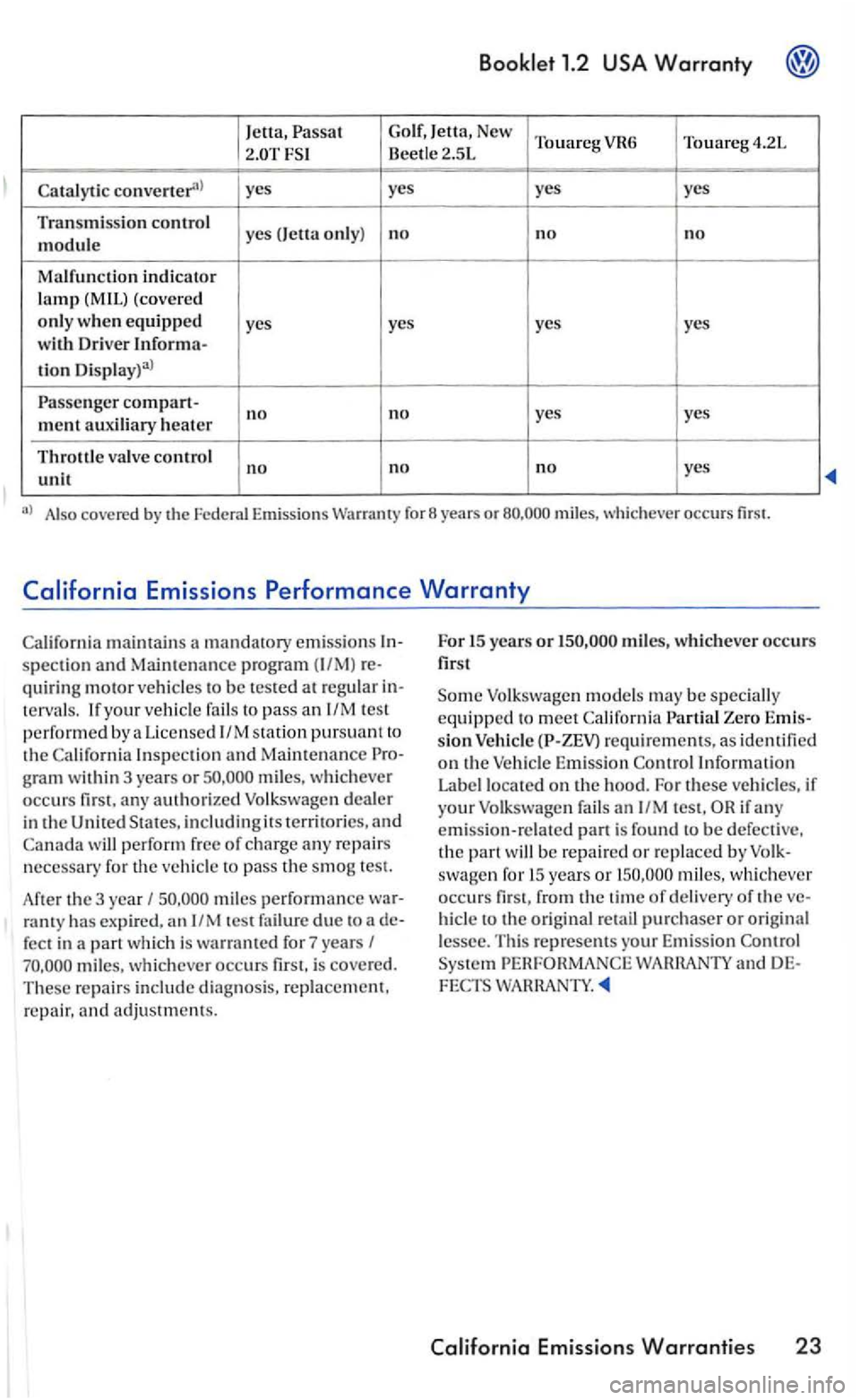
)etta, Golf, )etta, New TouaregVR6 Touareg 4.2L 2.5L
Ca
talyt ic ye s yes
yes yes
Transmission control yes etta only) module no no no
indicator lamp (MIL) (covered only when equipped yes yes ye s yes with Driver lnforma-
ti on
com part-no no yes yes ment auxiliary heater
Throttle val ve contro l unit no no no yes
a) Also covered by Emi ssio ns
quir ing motor vehicles to be tes ted at regular tervals. test performed by a Licensed station purs u a nt to the Ca lifornia Inspectio n and Mainten a nce gra m within3 years or miles, wh icheve r occurs fir st, any authorize d Vo lkswagen dealer in the United Sta tes, including its territori es, and will perform free of charge any re pair s
necessary f o r the ve hicl e to pa ss the smog tesl.
Afte r the 3 year mile s performance ranty has exp ired, an fect in a part which i s warranted for 7 years I mil es, whichever occurs first, is covered .
T hese repairs include diagnosis, replacement, repair, and adjustment s. For
mil
es, whichever occurs
first
Volkswage n models may be specially equipped to meet sion require m en ts, as identified on the Veh icle Emission Control Information Label located on the hood. For these ve hicles, if your Volkswagen fails an if any emiss ion -related pan is found to be defective, the part will be repai red or replaced by
hicle to the orig inal re tail purchaser or original
lessee. This represents your Emission Control WARRANTY and
Emissions Warranties 23
Page 316 of 444
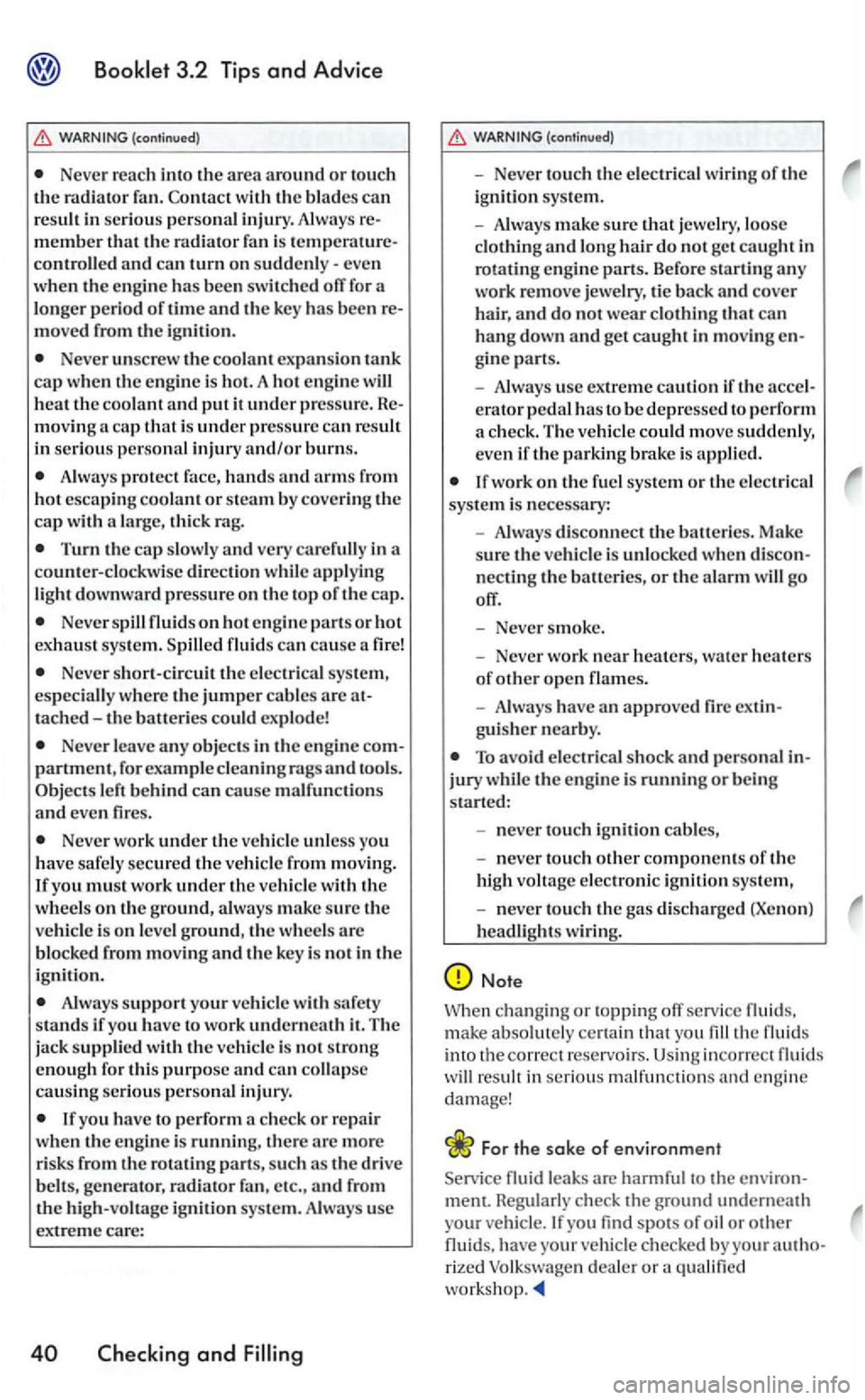
WARNING (continued)
Never reach into the area around or tou ch the radiator fan. Contact w ith the blade s can resuh in se riou s personal injury. Always m ember that the radiator fan is controll ed and can turn on
m oved from the ignit ion.
Never unscrew the coolant expa nsio n tank cap when th e engin e is hot. A hot engine will heat the coo la nt and put it under pressure . mov in g a cap that i s under pressure ca n rcsuh in seriou s personal injury and/or burns.
A lway s prote ct face, hand s and arms from hot esca ping coolant or steam b y cove ring the ca p with a large, thick rag.
Turn the cap slow ly a nd very carefully in a
counter- clo ckw ise direction whil e applying
light downward pressure on the top of the cap.
Never spill on hot engine parts o r hot
e xhau st sys te m . S pilled
Neve r short-circuitthc elec trica l sys te m ,
es peciall y w here th e jumper cabl es are tached -th e balleri es could explode!
Neve r leave any objects in the e ngine partment, for exam ple cleaning rag s and too ls. Objects
Neve r work unde r the veh ic le unless you
h ave safely secured th e ve hicl e from movin g.
I f yo u must work under th e ve hicl e wit h th e
w hee ls on th e ground, always make sure the vehicl e is on leve l ground, th e wh eels arc
b locked from movin g and th e key is not in the
ignition.
Always support your ve hicle with safety
s tands if you have to wo rk underneath it. The
ja ck suppli ed with the ve hicle is not s tron g enough for this purpose and can co llap se causin g se riou s personal injury.
If you have to perform a check or r ep a ir
w hen th e e ngine is running, there arc more
ri sks from
the ro tating parts, such as the drive
WARNING (con tinued)
Neve r to uch the e lec tr ica l w ir in g of the ig ni tio n sys tem.
Always make sure that j ewe lry, loose clothing and lo ng hair do not get caught in
rota ting engine pans. Before startin g any work remove jewelry, tie back and cover
hair, and do not wear clothing that can hang down and get caught in mov ing gin e parts.
Always use extre me cauti on if the erator pedal has to be depresse d to perform
a ch eck. The vehicle could move suddenly, eve n if the parking brake is applied.
If wor k on the fu el sys te m or th e electrica l
syste m is necessa ry:
Always discon nect th e balleries. Make
sure th e vehicle is unlo cked when
Neve r sm oke .
Neve r work nea r heaters, wa te r h eaters of other open names .
A lways have an approve d fire ext guis her nearby.
To avo id electrical shock and personal jury w hil e the eng ine is running or being
s tarted :
n ever touch ignition cables,
never to uch othe r component s of the
high vohage electronic ignition syste m,
never touch the gas discharged (Xeno n) headlights wiring.
Note
Whe n chang ing or topp ing orr service fluids. make absolutel y ce rtain that you fill the fluid s
into the corr ect reservoirs. Using incorrec t fluids will resuh in serious malf unct ions and engine
damage!
For the sake of environment
Service fluid leaks are harmful to the environ-
ment. Reg ularl y check the ground undernea th
your vehicle . you find spots of oil or other
fluids. have your vehic le checked by your rized dealer or a qualified
Page 323 of 444
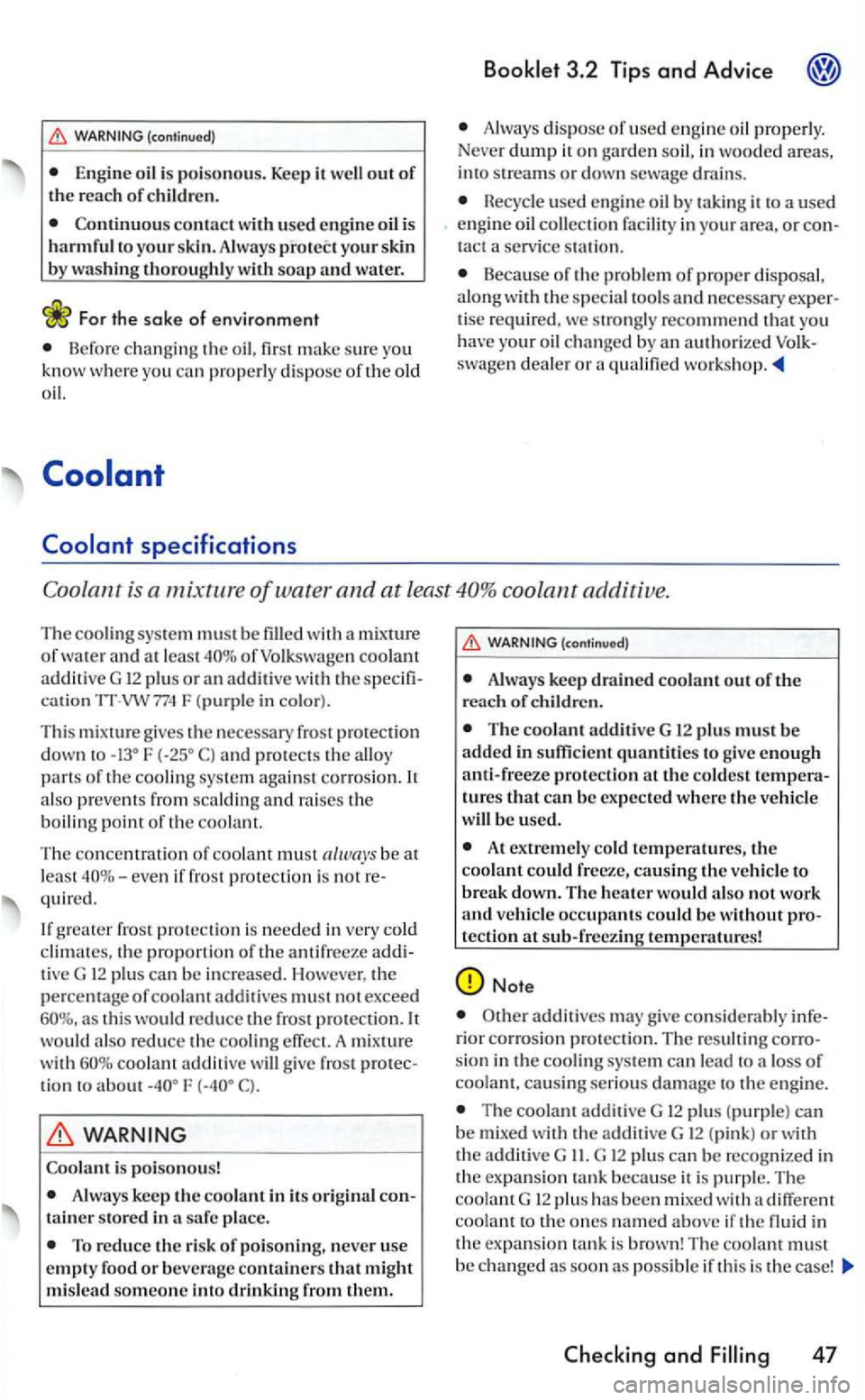
(cont;nuod)
Engine oil is po isonous. Keep it well out of the reach of child ren.
your skin by washing thoroughly w ith soap and wat er.
Fo r the sa ke of envir onment
Be fore changing oil, firs t m ake sure you kn ow where yo u can properly dispos e of the ol d
oil.
Alw ays d ispose of used engine oil properl y.
Neve r dump it on garden soil , in wooded area s,
int o streams or down sewage drains.
Recycle used eng in e oil by it to a u sed
eng in e oil colle ction fa ciliry in your area , o r ta ct a servic e sta tio n.
Because of t he proble m of proper disposal,
a long w ith the s pecial tools and n ecess ary tise re quired , we stro ngl y recommend that you hav e your oil changed by an authorize d swagen deale r or
Coolant is a mixture of wate r and at least cool ant additive.
The coolin g sys te m must be filled w ith mixture
o f water and of Volk s wa ge n coolant additive G 12 plu s or cati on
F and protects the alloy parts of the coolin g sys te m again st c o rrosio n. It
a lso prevent s from scalding and rai se s the
boiling point o f th e c oo la nt.
T he
concentration of coolant mus t be at leas t eve n if frost prote c tion is not quired .
If
greater fro st prot ection is needed in very cold climates, the proportion of the antifree ze ti ve G plu s can be in cre a se d. How ever, the percentage of coo as th is would reduce the fro st protectio n. would also reduce the c ooli ng effect. A mixture
with coolant additiv e will g iv e fro st tion
WARNING
Coolant is poison o us!
A lways keep the coolant in its original sa fe place.
Always keep drained coolant out o f th e
reach of children.
T he coolant addit ive G 12 plus must be added in sufficient quantities to g ive eno ugh
a nti-fr eeze protection at the col dest
At extremel y co ld temperatu res, the coolant could freeze, cau sing the vehicl e to break down. The heater would also not work and vehicle occupants could be without tection at sub-freezi ng temperatures!
Note
additi ves may giv e co nsi derably
sio n in the co olin g sys te m can lead to loss of
co olant, causin g s erio us damage to the eng ine.
The coolan t addit ive G 12 plus (purple) can be mixe d wi th the ad diti ve G 12 ( p in k) or wi th
t h e addit ive G II. G plu s can be rec og ni ze d in the ex p a nsio n tank because it is purp le . Th e
c o ol G 12 plus has been mi xed different c o o lan t to the ones na m ed above if t he
Page 334 of 444
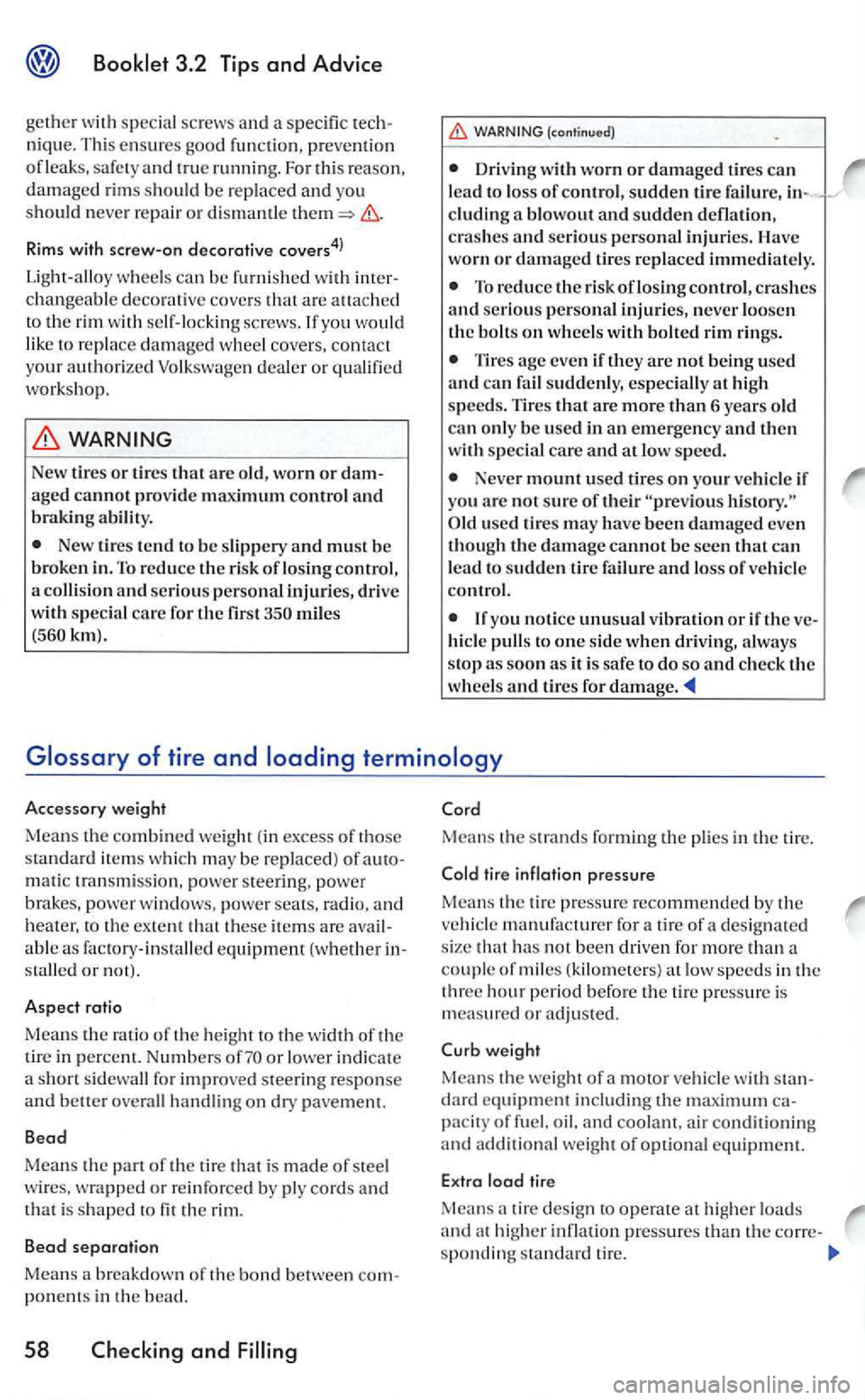
changea ble deco rat ive cove rs a re att ached to th e rim with s elf- locking sc rews . lfyou would ro re pla ce damaged wheel covers, contact your authorized Volkswa gen d eale r or
WARNING
New ti res or tires tha t are old, worn or aged cannot provide maximum control and braking ability.
New tires tend to be s lipp ery and must be broken in . To reduce the risk of losing co ntrol,
a co llisio n and serio us personal injuri es, drive with sp ecia l care for the first km).
(cont inued )
Driving with worn or damaged tire s can lead to lo ss of control, sudden tire failur e, cluding a blowou t and sudden deflation ,
c ras hes and seriou s personal injuries. Have wo rn or damaged tires rep laced imme di ate ly.
To redu ce the riskoflosingcontrol, crashes and s erio us personal injuries, never loose n
th e bolts on w heels with bolted rim rings.
more than 6 years old can onl y be used in an em erg en cy and then
w ith specia l care and at low speed.
Neve r m ount u se d tires on your ve hicle if
yo u are not sure of their used tires may have been damaged ev e n
t h oug h the damage cannot be seen th at can
lead to sudden tir e failure and loss of ve hicl e control.
hicl e pull s to one sid e when dri ving, always
s top as soo n as it is safe to do so and ch eck the
whee ls and tires for damage.
Accessory weight
Means the combined we ight ( in excess of those
sta ndard ite m s w hi ch may be repl aced) of mati c tran smission. power steering. po wer
bra kes, power windo ws. p owe r seats , radio, and heater, to th e ex te nt th at th ese item s are
or lowe r indica te
a short s id ewall for improved steering respo nse and better ove rall handling on dry pave ment.
Bead
Mean s the pa rt of the tire t hat is m ad e of stee l
wires , w rap ped or re inforce d by pl y cords and that is shap ed to fit t he rim.
Bead separation
Mean s a breakdow n of th e bond between
Means the strand s forming the in th e tire.
weight
Me ans th e weig ht of motor vehicl e w ith dard equ ipment including the m aximum pacity of fu el, oil. and coolant . a ir conditio nin g
a nd additional weight of opt io n al equipm ent.
E xtra load lire
M ea ns tire desi gn to operate at higher loads and at hi gher inflat ion pressure s th an th e corre -
s ponding sta ndard tire.
Page 376 of 444
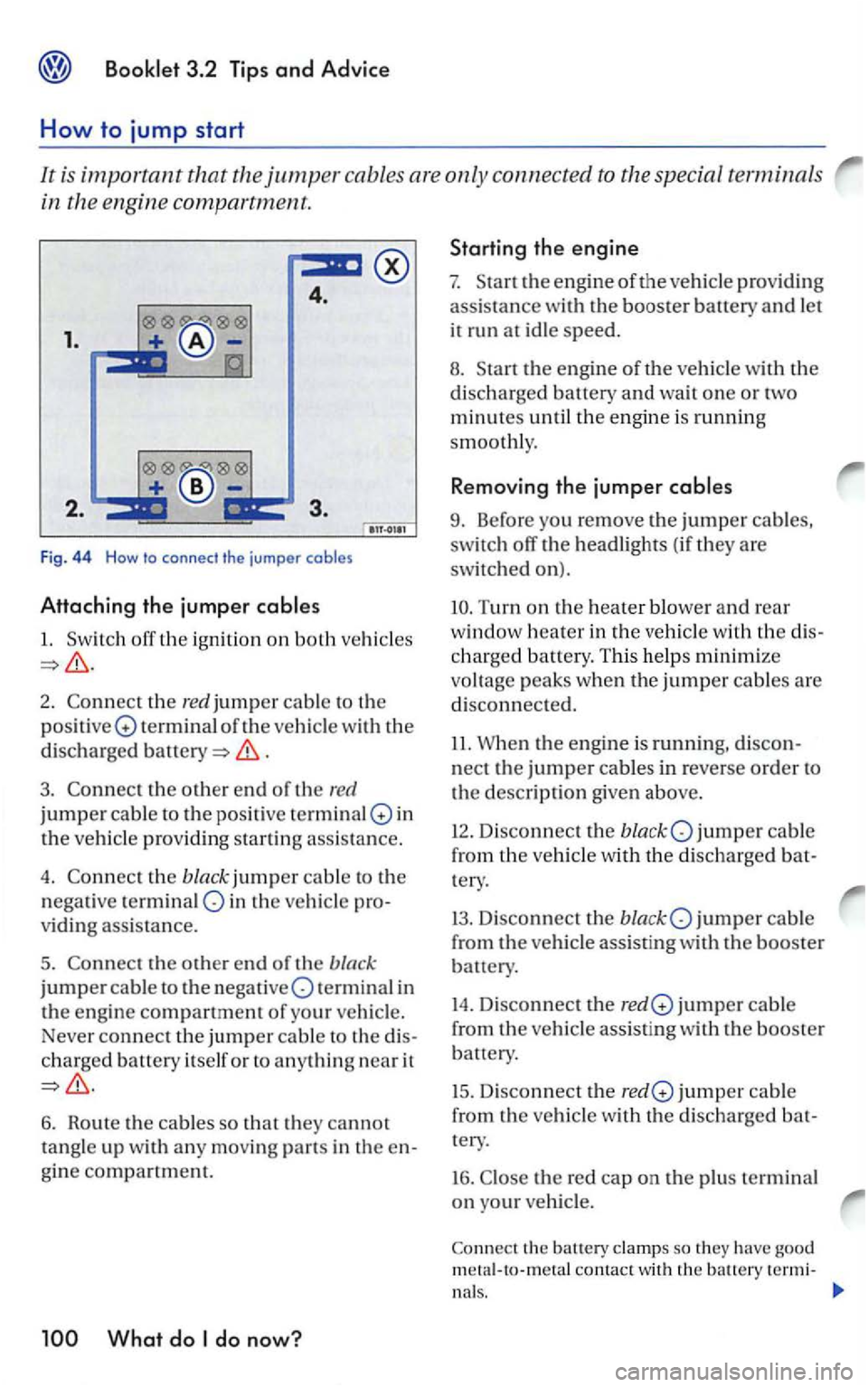
4.
1.
F ig. 44 How to connect the jumper cables
Attaching the jumper
1.
2. the red jumper cable to the
positi ve Q terminal of the vehicle with the
disch arg ed
.
3 . the other end of th e red
jumpe r cable to the posit ive terminal in
the veh icle providing startin g ass is ta n ce.
4. the black jumper ca ble to the
negative terminal in the vehic le
v idin g assistance.
5.
ch arged battery itself or to anything near it
6. Route the cables so that they cannot
tangle up with an y mo vin g parts in the
the engine of the vehicle with the
discharged battery and wait one or two
minutes until the engin e is running
s m
oothly.
Removing the jumper
9. Before you remove th e jumper cables,
switch off the headlights (if they are
switched on).
Turn on the heater blower and rear
window heater in the vehicl e with the
charged battery. This helps minimi ze
voltage peaks wh
en the jumper cables are
di sconnected.
11. Whe n the engine is running,
nect the jumper cables in r everse order to
the description given above.
12. Disconnect the jumper cable
fro m the vehicle with the di
scharged
jumper cable
from
the ve hicle assist ing with the booster
battery.
14. Disconn ect the jumper cabl e
from
the ve hicle assisting w ith the booste r
battery.
15. D isconnect the jumper ca ble
from the
vehicle with the discharged
th e re d cap on th e plu s te rminal
on your vehicle .
contact with the battery